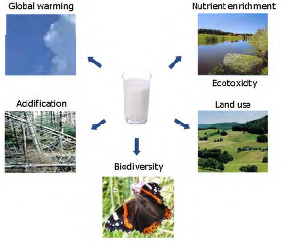What are the hot spots in the environmental performance of low input and organic dairy systems? How can the actors in the chain take action on these hot spot? How do those systems compare with other dairy chains? These are important questions that are being raised by the EU and stakeholders in the dairy chain and which we seek to address in SOLID WP 4.
By John E. Hermansen, Aarhus University, Foulum, Denmark
It is now clear the non-quota sectors like agriculture are being included in the reduction goals for greenhouse gas emissions. The EU road map to a competitive low carbon economy emphasize that efforts should be made to explore the possible benefits of less intensive farming systems taking into account the capacity of the farming system to sequester carbon. Likewise, the EU biodiversity strategy 2020 asks for means to halt loss of biodiversity.
Developing lifecycle methodology
For both global warming and biodiversity there is a link between what is happening at the individual farm and the resources that the farms depend upon, like imported feeds. The concept of life cycle assessment is very valuable to account for such interaction and therefore a key issue in this work is to develop and use lifecycle methodology
that particularly address the challenges and possible benefits of low input and organic dairy farming like land use requirement, carbon sequestration and biodiversity.
Performing life cycle assessment
When performing life cycle assessment a number of choices have to be taken, and several guidelines exist for doing so. For most classical impacts we adhere as much as possible to the work currently taking place in the European Food Sustainable Consumption and Production Round Table (SCP), which is supported by the food and drinks industry as well as the EU commission. We think this is important to have to best possible basis for
communication across products. However a main task for us is to expand these guidelines with impacts related to carbon sequestration in soils and biodiversity, which at the moment are not included.
Next step – test of conceptual framework
This work is going on right now, and we are confident that we can come up with a solid and well accepted methodology to take these impacts into account in an environmental assessment. Next steps are to test our conceptual framework in a real farm situation, and to validate how such information can be used in the dairy chain in congruence with other important dimensions of corporate social responsibility methodologies and efforts.

